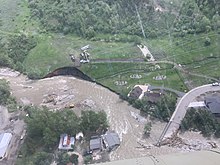Red Lodge, Montana
[4] The Red Lodge post office was established on December 9, 1884, with Postmaster Ezra L.
[5] A rail line was constructed into town, and coal shipments began in June 1889.
The majority came from Italy, the British Isles, Finland, Norway, Sweden, Germany, and Austria-Hungary.
In 1896, Red Lodge had twenty saloons and, as the library records show, riotous and violent living was characteristic of the town.
[7] Red Lodge suffered in the Great Depression, which forced many mines to close.
To offset this downturn, the manufacture of illegal bootleg liquor, labeled syrup, became an economic mainstay and was sold as far away as Chicago and San Francisco[citation needed].
In 1931 work began on the Beartooth Highway[8][9] linking Red Lodge to Yellowstone National Park; it was officially opened in 1936.
The buildings in downtown Red Lodge fell into disrepair in large part because population had dropped from its 1915 peak of 6,000 people to about 2,000.
About 30 miles to the southwest of town, in the Custer Gallatin National Forest, is Granite Peak, the highest point in Montana.
According to the United States Census Bureau, the city has a total area of 2.80 square miles (7.25 km2), all land.
[13] Red Lodge experiences a continental climate (Köppen Dfb) with cold, somewhat dry winters and warm, wetter summers.
Summers are cooler than in areas of Montana further north, due to the high elevation.
Winters however, are milder than areas further to the east due to the chinook wind influence, as with most of Montana.
[20] There are six members of the city council, elected from one of three wards of roughly equal population.
[26] The Yellowstone Bighorn Research Association's Geology Field Station is located south of Red Lodge.
[27] Red Lodge is well known for many outdoor recreation opportunities: skiing, mountain biking, fly fishing, and backpacking are nearby.





